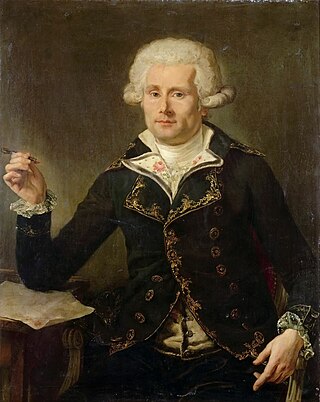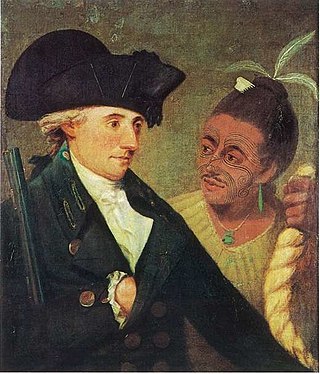Related Research Articles

Captain James Cook was a British explorer, cartographer and naval officer famous for his three voyages between 1768 and 1779 in the Pacific Ocean and to New Zealand and Australia in particular. He made detailed maps of Newfoundland prior to making three voyages to the Pacific, during which he achieved the first recorded European contact with the eastern coastline of Australia and the Hawaiian Islands, and the first recorded circumnavigation of New Zealand.

The War of 1812 was fought by the United States and its indigenous allies against the United Kingdom and its own indigenous allies in British North America, with limited participation by Spain in Florida. It began when the United States declared war on 18 June 1812. Although peace terms were agreed upon in the December 1814 Treaty of Ghent, the war did not officially end until the peace treaty was ratified by the United States Congress on 17 February 1815.

Louis-Antoine, Comte de Bougainville was a French admiral and explorer. A contemporary of the British explorer James Cook, he took part in the Seven Years' War in North America and the American Revolutionary War against Britain. Bougainville later gained fame for his expeditions, including a circumnavigation of the globe in a scientific expedition in 1763, the first recorded settlement on the Falkland Islands, and voyages into the Pacific Ocean. Bougainville Island of Papua New Guinea as well as the Bougainvillea flower are named after him.

George Dixon was an English sea captain, explorer, and maritime fur trader. George Dixon was "born in Leath Ward, a native of Kirkoswald". The son of Thomas Dixon, he was baptised in Kirkoswald on 8 July 1748.

HMS Dolphin was a 24-gun sixth-rate frigate of the Royal Navy. Launched in 1751, she was used as a survey ship from 1764 and made two circumnavigations of the world under the successive commands of John Byron and Samuel Wallis. She was the first ship to circumnavigate the world twice. She remained in service until she was paid off in September 1776. She was broken up in early 1777.

Captain Charles Clerke was an officer in the Royal Navy who sailed on four voyages of exploration, three with Captain James Cook. When Cook was killed during his 3rd expedition to the Pacific, Clerke took command but died later in the voyage from tuberculosis.

Andrew Lambert is a British naval historian, who since 2001 has been the Laughton Professor of Naval History in the Department of War Studies, King's College London.
Richard Alexander Hough was a British author and historian specializing in maritime history.

Isaac Smith (1752–1831) was a Rear Admiral in the Royal Navy and cousin of Elizabeth Cook wife of Captain James Cook, with whom he sailed on two voyages of exploration in the South Pacific. Smith was the first European to set foot in eastern Australia and the first to prepare survey maps of various Pacific islands and coastlines including Tierra del Fuego in South America.

HMS Eagle was a 58-gun fourth rate ship of the line of the Royal Navy built at King's Yard in Harwich by John Barnard and launched in 1745.

Léonard Victor Joseph Charner was an Admiral of the French Navy. As a commander of French naval forces in Asia from May 1860 to September 1861, including the Second Opium War and the Cochinchina campaign, he was a significant participant in the establishment of French Indochina.
This is a bibliography of works on the military history of Canada.
Barry Morton Gough is a global maritime and naval historian.

The era of European and American voyages of scientific exploration followed the Age of Discovery and were inspired by a new confidence in science and reason that arose in the Age of Enlightenment. Maritime expeditions in the Age of Discovery were a means of expanding colonial empires, establishing new trade routes and extending diplomatic and trade relations to new territories, but with the Enlightenment scientific curiosity became a new motive for exploration to add to the commercial and political ambitions of the past. See also List of Arctic expeditions and List of Antarctic expeditions.
Events from the year 1767 in France
Matavai Bay is a bay on the north coast of Tahiti, the largest island in the Windward group of French Polynesia. It is in the commune of Mahina, approximately 8 km east of the capital Pape'ete.
Events from the year 1729 in France
The Downs Station also known as the Commander-in-Chief, the Downs or Admiral Commanding at the Downs was a formation of the Kingdom of Great Britain and then the United Kingdom's Royal Navy based at Deal. It was a major command of the Royal Navy from 1626 until 1834.
Today the term South Seas, or South Sea, most commonly refers to the portion of the Pacific Ocean south of the equator. The term South Sea may also be used synonymously for Oceania, or even more narrowly for Polynesia or the Polynesian Triangle, an area bounded by the Hawaiian Islands, New Zealand and Easter Island. Pacific Islanders are commonly referred to as South Sea Islanders, particularly in Australia.
Étienne Taillemite was a French historian and archivist.
References
- ↑ Robson, John (April 2023). "President's Message". Cook's Log. Captain Cook Society. 46 (2): 2.
- ↑ Walberg, Rebecca (23 January 2010). "Coastlines defining Canadian characteristic". Winnipeg Free Press . Retrieved 26 June 2011.
- ↑ Woodcock, George (1981). "Review of The Black Cockade by Victor Suthren and A King's Ransom by Victor Suthren". Canadian Historical Review . 62 (2): 219–220.
- ↑ "Admiral of Fear". Kirkus Reviews . Retrieved November 11, 2018.
- ↑ "Captain Monsoon". Publishers Weekly . March 1, 1993. Retrieved November 11, 2018.
- ↑ Keshen, Jeff (2009). "Review Essay: The New Campaigns of Canadian Military Historians". American Review of Canadian Studies. 23 (3): 425–437. doi:10.1080/02722019309481838.
- ↑ "British Navy played a central role in the War of 1812". National Post. November 10, 2012.
- ↑ O'Connor, Tony (2001). "To Go upon Discovery". The International Hydrographic Review. 2 (1): 101–102.
- ↑ Robson, John (2005). "Book Review: The Sea Has No End: The Life of Louis-Antoine de Bougainville, Storms and Dreams: Louis de Bougainville, Soldier, Explorer, Statesman". International Journal of Maritime History. 17 (1): 377–378. doi:10.1177/084387140501700165. S2CID 165909675.
- ↑ Glavin, Terry (February 9, 2010). "Review: The Island of Canada, by Victor Suthren". The Globe and Mail . Retrieved November 11, 2018.
Victor Suthren, "A Museum of Tolerance", Maclean's Magazine, March 17, 2003.